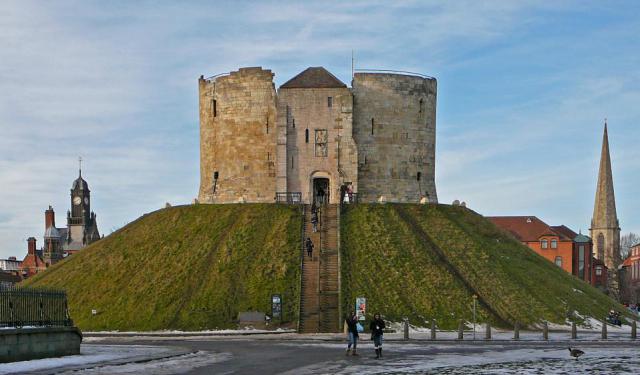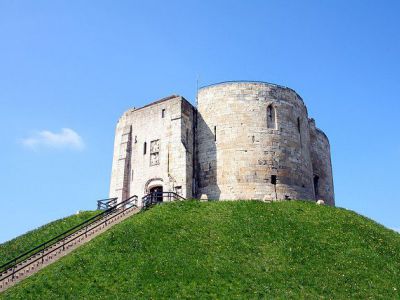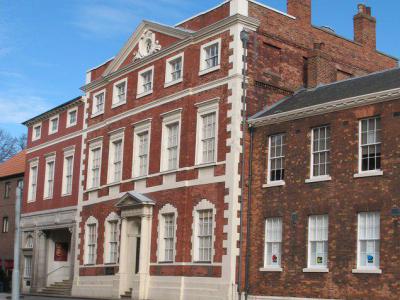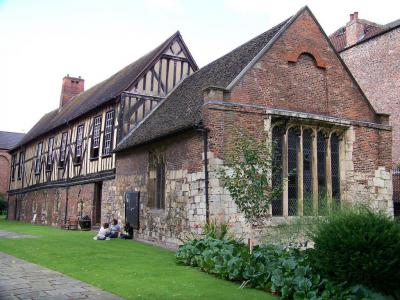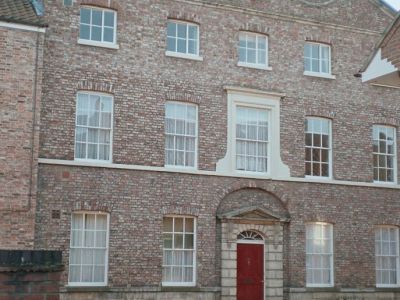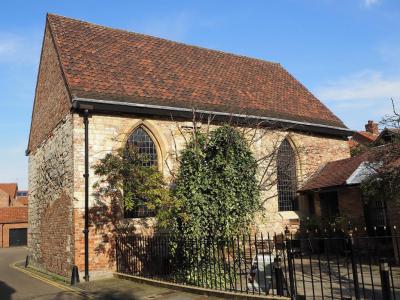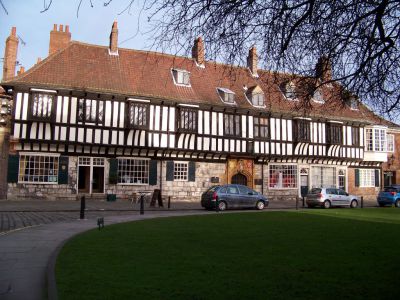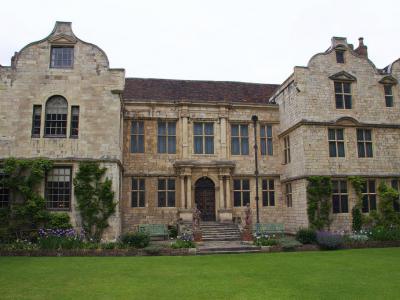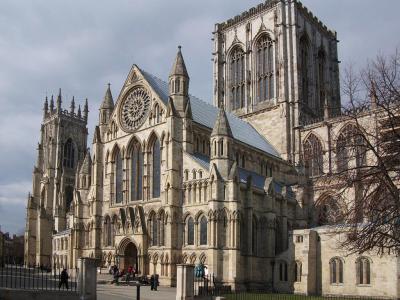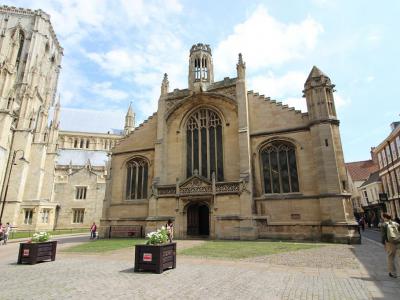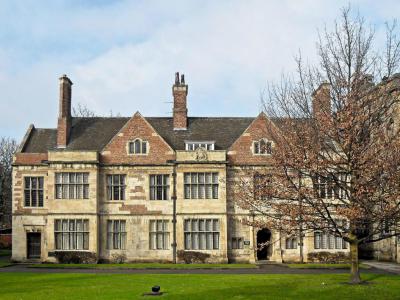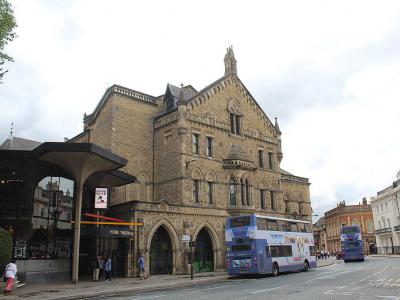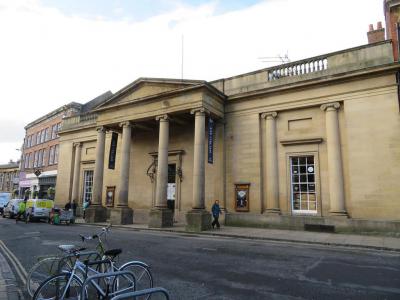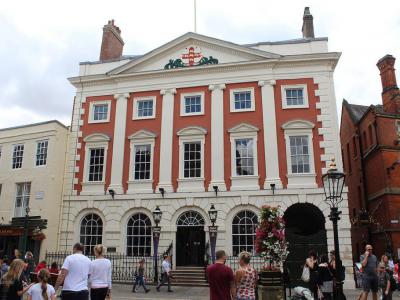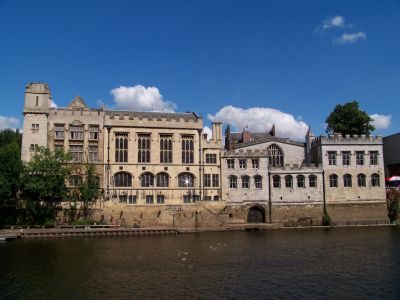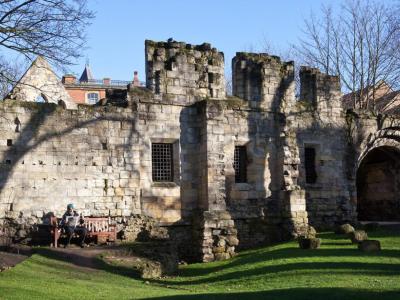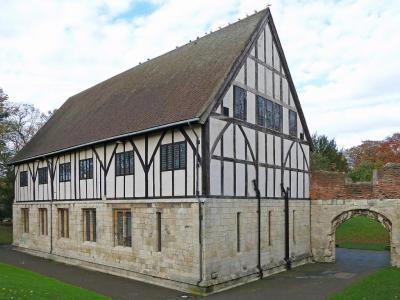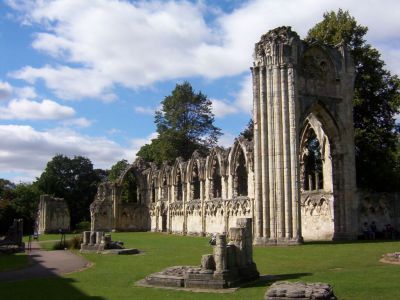York's Historical Architecture (Self Guided), York
Being home to some of the best preserved historic architecture in England, York screams history and is undoubtedly the must-go destination for anyone keen on the country’s past. While the more recent history has also characterized York, it is the abundance of the ancient sites retained in their variety – from Medieval times to the Georgian and Victorian eras, and more – that makes the city stand out from the crowd.
As you explore York you will discover that every aspect of its modern life is inextricably linked with its past. To get you started, here’s a list of some of the top architectural jewels worth visiting in the historic heart of the city.
Clifford's Tower – what’s left of the York Castle built by William the Conqueror; the iconic structure offers stunning views from its vantage point on top of a mound.
Fairfax House – a Georgian townhouse, displaying a collection of 18th-century furniture and period lifestyle; open to the public between February and December.
Merchant Adventurers' Hall – one of the most important medieval buildings, dated 1357; currently a museum, hosting collections of silver, furniture and paintings; open during summer.
Thomas Atkinson's House – an 18th-century, Gothic Revival edifice built by the English architect famous for remaking the Bishopthorpe Palace in York.
Treasurer's House – spanning 2,000 years of history, one of the first major properties of the National Trust since 1930; features a collection of antiques including furniture, ceramics, textiles and paintings.
The King's Manor – part of the University of York; originally built to house the abbots of St Mary's Abbey.
To discover the vast array of medieval and neoclassical buildings in York and to visit some of the best local museums, check out this self-guided walking tour.
As you explore York you will discover that every aspect of its modern life is inextricably linked with its past. To get you started, here’s a list of some of the top architectural jewels worth visiting in the historic heart of the city.
Clifford's Tower – what’s left of the York Castle built by William the Conqueror; the iconic structure offers stunning views from its vantage point on top of a mound.
Fairfax House – a Georgian townhouse, displaying a collection of 18th-century furniture and period lifestyle; open to the public between February and December.
Merchant Adventurers' Hall – one of the most important medieval buildings, dated 1357; currently a museum, hosting collections of silver, furniture and paintings; open during summer.
Thomas Atkinson's House – an 18th-century, Gothic Revival edifice built by the English architect famous for remaking the Bishopthorpe Palace in York.
Treasurer's House – spanning 2,000 years of history, one of the first major properties of the National Trust since 1930; features a collection of antiques including furniture, ceramics, textiles and paintings.
The King's Manor – part of the University of York; originally built to house the abbots of St Mary's Abbey.
To discover the vast array of medieval and neoclassical buildings in York and to visit some of the best local museums, check out this self-guided walking tour.
How it works: Download the app "GPSmyCity: Walks in 1K+ Cities" from Apple App Store or Google Play Store to your mobile phone or tablet. The app turns your mobile device into a personal tour guide and its built-in GPS navigation functions guide you from one tour stop to next. The app works offline, so no data plan is needed when traveling abroad.
York's Historical Architecture Map
Guide Name: York's Historical Architecture
Guide Location: England » York (See other walking tours in York)
Guide Type: Self-guided Walking Tour (Sightseeing)
# of Attractions: 17
Tour Duration: 2 Hour(s)
Travel Distance: 3.1 Km or 1.9 Miles
Author: val
Sight(s) Featured in This Guide:
Guide Location: England » York (See other walking tours in York)
Guide Type: Self-guided Walking Tour (Sightseeing)
# of Attractions: 17
Tour Duration: 2 Hour(s)
Travel Distance: 3.1 Km or 1.9 Miles
Author: val
Sight(s) Featured in This Guide:
- Clifford's Tower
- Fairfax House
- Merchant Adventurers' Hall
- Thomas Atkinson's House
- Bedern Hall
- Saint William's College
- Treasurer's House
- York Minster
- Saint Michael-le-Belfrey
- The King's Manor
- York Theatre Royal
- York Assembly Rooms
- Mansion House
- York Guildhall
- Saint Leonard's Hospital
- The Hospitium
- Saint Mary's Abbey
1) Clifford's Tower (must see)
Clifford's Tower in York is a historical site steeped in a rich and tumultuous past. It stands as the largest surviving part of York Castle, which was once northern England's most formidable medieval royal fortress. The tower has recently been enhanced with a significant update in 2022, which includes a dramatic roof deck, internal walkways, and a soundscape interpretation that narrates the tower's compelling history like never before. These new features make its history and interior more accessible, providing a vivid account of its dramatic and sometimes tragic events.
Originally constructed by William the Conqueror in 1068-69, Clifford's Tower was built to assert control over the rebellious north. The tower has endured multiple devastations, having been burned down twice before being reconstructed by Henry III in the 13th century. It is named after a particularly dark event where Roger de Clifford was executed for treason against Edward II and displayed on the tower walls.
Today, the tower's stone structure, dating from the late 13th century, invites visitors to explore its multifaceted history. The site is not only significant for its military and royal associations but also as a tragic site of the 1190 massacre of about 150 Jews who sought refuge there. Visitors can climb to the top of the tower to walk the open-air wall that guards once patrolled, offering unparalleled views of York, including the Old Minister, the North York Moors, and other remnants of York Castle.
From this vantage point, one can also view the "Eye of York"-a collection of buildings that includes the Female Prison, Debtor's Prison, and the Assize Courts, enhancing the understanding of York's historical and architectural development. The panoramic views from the tower make it an ideal starting point for anyone visiting the city.
The ground floor of Clifford's Tower, once the royal exchequer, now invites visitors to explore its history. A tactile model in the courtyard showcases its unique, possibly French-inspired four-lobed architecture. The first floor features a richly decorated chapel, formerly private apartments. Historically, the tower has served as a prison and royal mint, and it was here that the infamous highwayman Dick Turpin was identified, leading to his execution in 1739.
Originally constructed by William the Conqueror in 1068-69, Clifford's Tower was built to assert control over the rebellious north. The tower has endured multiple devastations, having been burned down twice before being reconstructed by Henry III in the 13th century. It is named after a particularly dark event where Roger de Clifford was executed for treason against Edward II and displayed on the tower walls.
Today, the tower's stone structure, dating from the late 13th century, invites visitors to explore its multifaceted history. The site is not only significant for its military and royal associations but also as a tragic site of the 1190 massacre of about 150 Jews who sought refuge there. Visitors can climb to the top of the tower to walk the open-air wall that guards once patrolled, offering unparalleled views of York, including the Old Minister, the North York Moors, and other remnants of York Castle.
From this vantage point, one can also view the "Eye of York"-a collection of buildings that includes the Female Prison, Debtor's Prison, and the Assize Courts, enhancing the understanding of York's historical and architectural development. The panoramic views from the tower make it an ideal starting point for anyone visiting the city.
The ground floor of Clifford's Tower, once the royal exchequer, now invites visitors to explore its history. A tactile model in the courtyard showcases its unique, possibly French-inspired four-lobed architecture. The first floor features a richly decorated chapel, formerly private apartments. Historically, the tower has served as a prison and royal mint, and it was here that the infamous highwayman Dick Turpin was identified, leading to his execution in 1739.
2) Fairfax House
Fairfax House, a splendid Georgian townhouse located on Castlegate in York, stands as a testament to the architectural and social history of the 18th century. Constructed in the early 1740s, initially for a local merchant, the property was acquired in 1759 by Charles Gregory Fairfax, the 9th Viscount Fairfax of Emley. Following the death of his wealthy wife, Elizabeth Clifford, Fairfax used his inheritance to purchase the house, intending it as a residence for his daughter, Ann Fairfax.
The house underwent significant renovations under the guidance of John Carr, a renowned architect, who was commissioned by Viscount Fairfax in 1761 to remodel the interiors. Completed in 1765, these renovations introduced exquisite plasterwork by James Henderson and Giuseppe Cortese and detailed carved woodwork. The house also featured impressive wrought iron balustrades and gates crafted by Maurice Tobin, although these were later removed during street widening.
Over the centuries, Fairfax House had various incarnations – from a gentleman's club to a cinema named Saint George's Hall. By the mid-20th century, the building had fallen into disrepair. It was not until the 1980s that the York Civic Trust purchased and meticulously restored it to its former grandeur.
Today, Fairfax House operates as a public museum, managed by the York Civic Trust. It is celebrated not only for its architectural beauty but also for housing a growing collection of Georgian artifacts, including a Grinling Gibbons panel and a recently acquired portrait of Elizabeth Clifford. The museum is dedicated to the exploration and exhibition of Georgian life, offering a variety of exhibitions, live performances, and audio-visual displays that highlight 18th-century British culture.
Why You Should Visit:
To get a feel for what it was like to live as an aristocrat in a Georgian home. Better than visiting a castle or a palace, as you can get very close to all of the displays – no velvet ropes here!
Friendly volunteers are stationed throughout the house offering an excellent level of historical detail and their color commentary, complete with pithy British humor.
Tip:
If available on a Monday, make sure you catch one of the tours as it will make your visit more personal, with less external chatter from other guests.
Remember to look up at the ceilings. They also have a gift shop which is well stocked with unusual gifts and interesting in its own right.
The house underwent significant renovations under the guidance of John Carr, a renowned architect, who was commissioned by Viscount Fairfax in 1761 to remodel the interiors. Completed in 1765, these renovations introduced exquisite plasterwork by James Henderson and Giuseppe Cortese and detailed carved woodwork. The house also featured impressive wrought iron balustrades and gates crafted by Maurice Tobin, although these were later removed during street widening.
Over the centuries, Fairfax House had various incarnations – from a gentleman's club to a cinema named Saint George's Hall. By the mid-20th century, the building had fallen into disrepair. It was not until the 1980s that the York Civic Trust purchased and meticulously restored it to its former grandeur.
Today, Fairfax House operates as a public museum, managed by the York Civic Trust. It is celebrated not only for its architectural beauty but also for housing a growing collection of Georgian artifacts, including a Grinling Gibbons panel and a recently acquired portrait of Elizabeth Clifford. The museum is dedicated to the exploration and exhibition of Georgian life, offering a variety of exhibitions, live performances, and audio-visual displays that highlight 18th-century British culture.
Why You Should Visit:
To get a feel for what it was like to live as an aristocrat in a Georgian home. Better than visiting a castle or a palace, as you can get very close to all of the displays – no velvet ropes here!
Friendly volunteers are stationed throughout the house offering an excellent level of historical detail and their color commentary, complete with pithy British humor.
Tip:
If available on a Monday, make sure you catch one of the tours as it will make your visit more personal, with less external chatter from other guests.
Remember to look up at the ceilings. They also have a gift shop which is well stocked with unusual gifts and interesting in its own right.
3) Merchant Adventurers' Hall
This guildhall in the city of York was one of the most important buildings in the medieval city. The majority of the Hall was built in 1357 by a group of influential men and women who came together to form a religious fraternity called the Guild of Our Lord Jesus and the Blessed Virgin Mary. The main part of the building consists of the Great Hall, the Undercroft and the Chapel.
The Great Hall is where is where the medieval merchants first gathered to conduct their business and to socialize. It is the largest timber-framed building in the UK still standing and used for its original purpose. The roof of the hall is of two spans supported by a row of large central timber posts. It includes complex crown posts and is held together by wooden pegs.
The Undercroft was was originally a hospital or almshouse for poor people of York. Like the Great Hall, the Undercroft is divided in two by its supporting row of timber posts. The undercroft also provides access to an attached chapel.
The Chapel was build for the spiritual use of the ill and poor in the hospital as well as the members of the the Merchant Adventurers' Guild. It is still used for worship today.
Merchant Adventurers' Hall is one of the best preserved medieval guildhalls in the world and is well worth being included on your York itinerary.
The Great Hall is where is where the medieval merchants first gathered to conduct their business and to socialize. It is the largest timber-framed building in the UK still standing and used for its original purpose. The roof of the hall is of two spans supported by a row of large central timber posts. It includes complex crown posts and is held together by wooden pegs.
The Undercroft was was originally a hospital or almshouse for poor people of York. Like the Great Hall, the Undercroft is divided in two by its supporting row of timber posts. The undercroft also provides access to an attached chapel.
The Chapel was build for the spiritual use of the ill and poor in the hospital as well as the members of the the Merchant Adventurers' Guild. It is still used for worship today.
Merchant Adventurers' Hall is one of the best preserved medieval guildhalls in the world and is well worth being included on your York itinerary.
4) Thomas Atkinson's House
Thomas Atkinson, a distinguished 18th-century English architect, is perhaps best known for his Gothic Revival redesign of Bishopthorpe Palace in York. However, beyond his professional achievements, little is known about Atkinson's personal life. One of the few remaining insights into his private world is his residence on Andrewgate in York, which he built around 1780.
The house on Andrewgate serves not just as a personal residence but as a reflection of Atkinson's architectural ethos. Built when he was establishing his practice, this house remains a standing testament to his influence and style. Located in the heart of York, the residence exemplifies the period's architectural characteristics and Atkinson's preferences.
Atkinson's conversion to Roman Catholicism significantly shaped his professional path, earning him numerous commissions from the Yorkshire Catholic gentry. Noteworthy among these is the design of a new chapel for the Bar Convent in York. The chapel featured a concealed dome hidden beneath a slate roof, a strategic design to keep the building unnoticeable. Furthermore, Atkinson ingeniously integrated eight different escape routes into the chapel's design, providing worshippers a means of escape in case of an attack.
Today, Thomas Atkinson's house on Andrewgate stands as a cultural and historical artifact, offering one of the few glimpses into the life of a man who shaped the architectural heritage of Yorkshire. His contributions go beyond the buildings he created, encompassing thoughtful designs that considered both aesthetics and the safety of the building's occupants. The house not only symbolizes Atkinson's architectural legacy but also enriches the historical fabric of York.
The house on Andrewgate serves not just as a personal residence but as a reflection of Atkinson's architectural ethos. Built when he was establishing his practice, this house remains a standing testament to his influence and style. Located in the heart of York, the residence exemplifies the period's architectural characteristics and Atkinson's preferences.
Atkinson's conversion to Roman Catholicism significantly shaped his professional path, earning him numerous commissions from the Yorkshire Catholic gentry. Noteworthy among these is the design of a new chapel for the Bar Convent in York. The chapel featured a concealed dome hidden beneath a slate roof, a strategic design to keep the building unnoticeable. Furthermore, Atkinson ingeniously integrated eight different escape routes into the chapel's design, providing worshippers a means of escape in case of an attack.
Today, Thomas Atkinson's house on Andrewgate stands as a cultural and historical artifact, offering one of the few glimpses into the life of a man who shaped the architectural heritage of Yorkshire. His contributions go beyond the buildings he created, encompassing thoughtful designs that considered both aesthetics and the safety of the building's occupants. The house not only symbolizes Atkinson's architectural legacy but also enriches the historical fabric of York.
5) Bedern Hall
Bedern Hall in York is a historic site with a rich legacy that stretches back to the 14th century. Originally serving as the refectory for the Vicars Choral, singers at nearby York Minster, the hall has maintained its tradition of hospitality and communal gathering through the centuries. Today, it stands as a Grade II* listed building, a testament to its architectural and historical significance.
Located just a short distance from York Minster, Bedern Hall is seamlessly integrated into the fabric of this ancient city, making it a prime location for various events. The hall offers a unique blend of medieval charm and modern amenities, making it an ideal venue for weddings, business meetings, and personal celebrations. Its medieval timber framing, York stone floor, and soaring beamed roof space provide a memorable backdrop, enriched by modern facilities that ensure comfort for all visitors.
The hall's catering services are provided by a resident team, led by Roger Lee, whose family business emphasizes flexibility and quality. The menus are crafted with care, often featuring seasonal ingredients sourced from across Yorkshire, which underscores the hall's commitment to local produce and high culinary standards.
Furthermore, Bedern Hall's association with three of York’s ancient Guilds adds a layer of historical depth, enhancing the ceremonial and communal atmosphere of the venue. With options for both indoor and outdoor gatherings, including a courtyard and garden terrace that are perfect for photographs, Bedern Hall offers a picturesque setting that combines the allure of the past with the conveniences of the present.
Located just a short distance from York Minster, Bedern Hall is seamlessly integrated into the fabric of this ancient city, making it a prime location for various events. The hall offers a unique blend of medieval charm and modern amenities, making it an ideal venue for weddings, business meetings, and personal celebrations. Its medieval timber framing, York stone floor, and soaring beamed roof space provide a memorable backdrop, enriched by modern facilities that ensure comfort for all visitors.
The hall's catering services are provided by a resident team, led by Roger Lee, whose family business emphasizes flexibility and quality. The menus are crafted with care, often featuring seasonal ingredients sourced from across Yorkshire, which underscores the hall's commitment to local produce and high culinary standards.
Furthermore, Bedern Hall's association with three of York’s ancient Guilds adds a layer of historical depth, enhancing the ceremonial and communal atmosphere of the venue. With options for both indoor and outdoor gatherings, including a courtyard and garden terrace that are perfect for photographs, Bedern Hall offers a picturesque setting that combines the allure of the past with the conveniences of the present.
6) Saint William's College
Saint William's College in York is a historic Grade I listed building initially constructed to house priests serving in chantry chapels at the nearby York Minster. Founded in 1460 by George Neville and the Earl of Warwick, the college was named after Saint William of York and was designed to accommodate twenty-three priests and a provost.
Construction of the current courtyard-style building began in 1465, possibly integrating parts of two pre-existing houses. The layout included a grand hall to the north and a chapel to the east. Although the Great Hall still partially remains, modifications over the centuries have altered its original appearance, including a lowered ceiling and new plasterwork added in 1910. Notable architectural features such as the posts of a screen passage and the original kitchen's fireplace continue to highlight its medieval origins.
The building experienced significant changes during the Dissolution of the Monasteries, transitioning into a substantial residential house by 1548. Noteworthy residents have included Charles Howard, 3rd Earl of Carlisle. This period also saw the addition of a main staircase that still exists today and the creation of the "Bishop's Chamber" in the seventeenth century, which remains largely unchanged.
Commercial adaptations in the eighteenth century introduced retail spaces on the ground floor and the addition of bow windows, elements that have persisted into the present. The building's exterior retains much of its original structure, with a stone ashlar ground floor and a timber-framed upper floor. Despite the replacement of the main doorway, the coats of arms dating from around 1670 and carvings of Saint Christopher and the Virgin and Child by the entrance survive, adding to the historical and architectural significance of Saint William's College.
Construction of the current courtyard-style building began in 1465, possibly integrating parts of two pre-existing houses. The layout included a grand hall to the north and a chapel to the east. Although the Great Hall still partially remains, modifications over the centuries have altered its original appearance, including a lowered ceiling and new plasterwork added in 1910. Notable architectural features such as the posts of a screen passage and the original kitchen's fireplace continue to highlight its medieval origins.
The building experienced significant changes during the Dissolution of the Monasteries, transitioning into a substantial residential house by 1548. Noteworthy residents have included Charles Howard, 3rd Earl of Carlisle. This period also saw the addition of a main staircase that still exists today and the creation of the "Bishop's Chamber" in the seventeenth century, which remains largely unchanged.
Commercial adaptations in the eighteenth century introduced retail spaces on the ground floor and the addition of bow windows, elements that have persisted into the present. The building's exterior retains much of its original structure, with a stone ashlar ground floor and a timber-framed upper floor. Despite the replacement of the main doorway, the coats of arms dating from around 1670 and carvings of Saint Christopher and the Virgin and Child by the entrance survive, adding to the historical and architectural significance of Saint William's College.
7) Treasurer's House (must see)
In the care of the National Trust since 1930 (it was one of its first major properties), and tucked away behind the Minster, the Treasurer's House has both a lovely garden and fascinating collection of art and antiques.
The name derives from it being on the site of the medieval house of the Minster's Treasurer, a post abolished at the Reformation. The present building dates from the 17th century, but had been added to with various accretions and was actually three separate houses when in 1897 it was bought by Frank Green (1861-1954).
Green was a wealthy local industrialist and used his considerable wealth and educated taste to restore the house to what he thought it should look like in its heyday, albeit with a central great hall which was entirely of his own imagination.
He was an early collector of antiques, and his aim to deliver a home as a showcase for his collection of furniture, paintings and other treasures, with great attention to paid to the detail of their presentation. Each room was designed in the style of a different period as a setting for his period furniture collection.
He was famously fastidious – not to say fussy – and the house abounds with notices telling the staff what to do and how to behave, and metal floor studs to indicate the exact position of the furniture. It is said he even wandered around to check on things at night! A bachelor, he gave the house to the Trust in 1930, while he moved on to Ashwick House in Somerset.
Visitors can wander on their own, and there is an audio guide available on request, as well as braille and large print guides. In each room, there is a separate guide to the paintings on display. Afterwards, the gardens make a great place to escape the touristy bustle of the city.
Tip:
To reach the cellar and attic you need to go on an accompanied tour: the cellar tour is mainly of interest to ghost enthusiasts (there are still people who claim to see them!), while the attic tour gives a great insight into the servants' lives. You can also have a wander round the very pleasant, photogenic garden and go down in the basement to find a reasonably priced tearoom, toilets, and maybe a ghost or two.
The name derives from it being on the site of the medieval house of the Minster's Treasurer, a post abolished at the Reformation. The present building dates from the 17th century, but had been added to with various accretions and was actually three separate houses when in 1897 it was bought by Frank Green (1861-1954).
Green was a wealthy local industrialist and used his considerable wealth and educated taste to restore the house to what he thought it should look like in its heyday, albeit with a central great hall which was entirely of his own imagination.
He was an early collector of antiques, and his aim to deliver a home as a showcase for his collection of furniture, paintings and other treasures, with great attention to paid to the detail of their presentation. Each room was designed in the style of a different period as a setting for his period furniture collection.
He was famously fastidious – not to say fussy – and the house abounds with notices telling the staff what to do and how to behave, and metal floor studs to indicate the exact position of the furniture. It is said he even wandered around to check on things at night! A bachelor, he gave the house to the Trust in 1930, while he moved on to Ashwick House in Somerset.
Visitors can wander on their own, and there is an audio guide available on request, as well as braille and large print guides. In each room, there is a separate guide to the paintings on display. Afterwards, the gardens make a great place to escape the touristy bustle of the city.
Tip:
To reach the cellar and attic you need to go on an accompanied tour: the cellar tour is mainly of interest to ghost enthusiasts (there are still people who claim to see them!), while the attic tour gives a great insight into the servants' lives. You can also have a wander round the very pleasant, photogenic garden and go down in the basement to find a reasonably priced tearoom, toilets, and maybe a ghost or two.
8) York Minster (must see)
The York Minister is an impressive cathedral with a long and storied history. The Romans settled here and named the area Eboracum in 71 AD. King Edwin was baptized in a small wooden church here in 625. A stone church was built, and King Edwin was buried in the stone church in 633. In 1088, a new Minister was built. The Minister was expanded between 1154 and 1225. In 1328, the York Minister hosted a royal wedding between King Edward III and Philippa of Hainault.
Richard Scrope, Archbishop of York, was accused of treason by Henry IV and beheaded in 1405. His tomb lies in the Minister.
The Minister as it stands today was completed in 1471. It is the second-largest Gothic cathedral in Northern Europe. The name "minister" harkens to Anglo-Saxon missionary churches. The cathedral's official name is the Cathedral and Metropolitical Church of Saint Peter in York.
The Minister features majestic architecture, including a Gothic nave and a Perpendicular Gothic quire. The 1408 Great East Window is the largest expanse of stained glass in the world. Each lancet in the magnificent Five Sisters Window is 53 feet tall. A gorgeous rose window graces the south transept. The design of the west window is known as The Heart of Yorkshire.
The transepts feature wooden roofs. The nave was completed in 1350 and is England's widest Gothic nave. The central tower is 235 feet tall (72 meters). The choir is 102 feet tall (31 meters). The octagonal Chapter House was built in 1280 and features wonderful stone carvings.
Visitors can view the remains of the Roman fort in the cathedral's museum.
Why You Should Visit:
The York Minister is one of the most impressive churches in Northern Europe. It was one of the few Catholic churches not destroyed by Henry VIII, as he wanted to convert it to an Anglican church. The soaring nave, impressive towers, storied history, and Gothic architecture are the highlight of any York visit.
Tips:
Go for an evensong service, usually held in the evenings at 5:15 pm, and experience the acoustic wonders of the choir and organ.
The 35 church bells ring at 10:00 am on Sundays.
Richard Scrope, Archbishop of York, was accused of treason by Henry IV and beheaded in 1405. His tomb lies in the Minister.
The Minister as it stands today was completed in 1471. It is the second-largest Gothic cathedral in Northern Europe. The name "minister" harkens to Anglo-Saxon missionary churches. The cathedral's official name is the Cathedral and Metropolitical Church of Saint Peter in York.
The Minister features majestic architecture, including a Gothic nave and a Perpendicular Gothic quire. The 1408 Great East Window is the largest expanse of stained glass in the world. Each lancet in the magnificent Five Sisters Window is 53 feet tall. A gorgeous rose window graces the south transept. The design of the west window is known as The Heart of Yorkshire.
The transepts feature wooden roofs. The nave was completed in 1350 and is England's widest Gothic nave. The central tower is 235 feet tall (72 meters). The choir is 102 feet tall (31 meters). The octagonal Chapter House was built in 1280 and features wonderful stone carvings.
Visitors can view the remains of the Roman fort in the cathedral's museum.
Why You Should Visit:
The York Minister is one of the most impressive churches in Northern Europe. It was one of the few Catholic churches not destroyed by Henry VIII, as he wanted to convert it to an Anglican church. The soaring nave, impressive towers, storied history, and Gothic architecture are the highlight of any York visit.
Tips:
Go for an evensong service, usually held in the evenings at 5:15 pm, and experience the acoustic wonders of the choir and organ.
The 35 church bells ring at 10:00 am on Sundays.
9) Saint Michael-le-Belfrey
Saint Michael-le-Belfrey in York holds a significant place in the city's rich historical tapestry. The current structure was erected between 1525 and 1537, replacing an older building that dated back to at least 1294. This construction occurred during the reign of Henry VIII, reflecting the Tudor Gothic architectural style prominent at that time.
The church is perhaps most famously known as the baptismal site of Guy Fawkes, born in 1570. Fawkes, who later played a central role in the infamous Gunpowder Plot of 1605, was baptized here, and today, visitors to the church can view an enlarged copy of his baptismal entry. This historic link adds a layer of national significance to the church.
Architecturally, the church underwent significant changes in 1867, especially on its west front and bellcote, which were supervised by the architect George Fowler Jones. These enhancements were part of broader modifications that occurred when adjacent houses were demolished, providing the church with a more prominent facade.
Inside, the church is renowned for its stunning stained glass collections, some of the oldest dating back to around 1330, originally from the church that preceded the current building. This glass, notably in the East window, complements the late medieval glass from its 16th-century reconstruction found in the aisles. The interior also features a remarkable 18th-century Baroque altarpiece, and extensive collections of 18th-century monuments, and memorials, enriching its spiritual and historical environment.
Additionally, Saint Michael-le-Belfrey is known as a center for charismatic revival, highlighting its ongoing importance in contemporary religious and community life. Its architectural beauty combined with its deep historical and cultural significance makes Saint Michael-le-Belfrey a cornerstone of York's heritage and a fascinating destination for both historical and religious scholars, as well as tourists.
Tip:
When the sun is going down this church does stand out!
The church is perhaps most famously known as the baptismal site of Guy Fawkes, born in 1570. Fawkes, who later played a central role in the infamous Gunpowder Plot of 1605, was baptized here, and today, visitors to the church can view an enlarged copy of his baptismal entry. This historic link adds a layer of national significance to the church.
Architecturally, the church underwent significant changes in 1867, especially on its west front and bellcote, which were supervised by the architect George Fowler Jones. These enhancements were part of broader modifications that occurred when adjacent houses were demolished, providing the church with a more prominent facade.
Inside, the church is renowned for its stunning stained glass collections, some of the oldest dating back to around 1330, originally from the church that preceded the current building. This glass, notably in the East window, complements the late medieval glass from its 16th-century reconstruction found in the aisles. The interior also features a remarkable 18th-century Baroque altarpiece, and extensive collections of 18th-century monuments, and memorials, enriching its spiritual and historical environment.
Additionally, Saint Michael-le-Belfrey is known as a center for charismatic revival, highlighting its ongoing importance in contemporary religious and community life. Its architectural beauty combined with its deep historical and cultural significance makes Saint Michael-le-Belfrey a cornerstone of York's heritage and a fascinating destination for both historical and religious scholars, as well as tourists.
Tip:
When the sun is going down this church does stand out!
10) The King's Manor
The King's Manor, located in the heart of York, on Exhibition Square, is a historically rich Grade I listed building that currently forms part of the University of York's campus. The history of this site stretches back to the eleventh century, though the oldest extant parts of the building date from the fifteenth century. Originally, King's Manor served as the residence for the abbots of Saint Mary's Abbey, York.
After the dissolution of the monasteries in 1539 by Henry VIII, King's Manor was repurposed to house the Council of the North, a body established to govern the northern regions of England. It fulfilled this role until the Council was disbanded in 1641. Subsequently, from 1667 to 1688, it became the official residence of the Governor of York. During the Glorious Revolution in 1688, the building played a dramatic role in English history. It was seized from Sir John Reresby, the then-Governor who remained loyal to James II, by forces loyal to William of Orange led by Thomas Osborne, Earl of Danby.
Following the upheaval of the Glorious Revolution, King's Manor was leased to private tenants for over a century. In the nineteenth century, it found a new purpose as the premises expanded to accommodate the Yorkshire School for the Blind, which occupied the building until 1958. The departure of the Blind School marked another chapter for the Manor, as it was then acquired by the York City Council.
In 1963, the council leased King's Manor to the University of York. Since then, it has been an integral part of the university, housing various academic departments and providing a picturesque and historically evocative setting for education and research. This storied building not only serves as a link to the rich medieval and early modern history of York but also continues to be a vibrant part of its educational landscape.
After the dissolution of the monasteries in 1539 by Henry VIII, King's Manor was repurposed to house the Council of the North, a body established to govern the northern regions of England. It fulfilled this role until the Council was disbanded in 1641. Subsequently, from 1667 to 1688, it became the official residence of the Governor of York. During the Glorious Revolution in 1688, the building played a dramatic role in English history. It was seized from Sir John Reresby, the then-Governor who remained loyal to James II, by forces loyal to William of Orange led by Thomas Osborne, Earl of Danby.
Following the upheaval of the Glorious Revolution, King's Manor was leased to private tenants for over a century. In the nineteenth century, it found a new purpose as the premises expanded to accommodate the Yorkshire School for the Blind, which occupied the building until 1958. The departure of the Blind School marked another chapter for the Manor, as it was then acquired by the York City Council.
In 1963, the council leased King's Manor to the University of York. Since then, it has been an integral part of the university, housing various academic departments and providing a picturesque and historically evocative setting for education and research. This storied building not only serves as a link to the rich medieval and early modern history of York but also continues to be a vibrant part of its educational landscape.
11) York Theatre Royal
York Theatre Royal, located at Saint Leonard's Place in York, is a historic venue with roots extending back to 1744. The theatre, with a seating capacity 750, features a traditional proscenium stage that was reconfigured in 2011 to support in-the-round productions. The York Theatre Royal actively engages in the performing arts, producing its shows and hosting national touring groups like Pilot Theatre. It also supports local amateur dramatic and operatic societies by offering access to its main stage and studio.
The site itself is historically rich, built on the remains of medieval Saint Leonard's Hospital; remnants of the hospital, including archways and walls, are visible within the modern structure. Beneath the stage lies a well, believed to date back to Roman times.
The theatre's ownership changed in 1769 when Tate Wilkinson acquired a Royal Patent, leading to its renaming as the Theatre Royal. Wilkinson's leadership marked a golden era, attracting renowned actors such as John Philip Kemble, Sarah Siddons, Dorothea Jordan, and Elizabeth Farren.
Architectural revisions have been a constant part of the theatre's history. It underwent Victorian-style refurbishments in the late 1800s, adding a Gothic Revival frontage in 1879. The interior was redesigned in 1902, and a significant modernist foyer was added in 1967 by Patrick Gwynne. The latest redevelopment, completed in 2016, modernized facilities while enhancing environmental and accessibility standards.
Today, York Theatre Royal stands as a Grade II* listed building, recognized by Historic England for its architectural and historical significance. This venue continues to be a central part of York's cultural landscape, blending its rich history with a commitment to contemporary theatre and community involvement.
Why You Should Visit:
While the entrance is modern and functional, the theatre itself has maintained all of its historic charm, and the variety & quality of shows for children as much for adults are excellent.
The new café created downstairs, with glass windows looking out through the gothic arches, offers the expected cakes and drinks at very reasonable prices.
Tip:
If you only do one pantomime performance, make sure it is the one here – quite unique and an experience you won't forget.
The site itself is historically rich, built on the remains of medieval Saint Leonard's Hospital; remnants of the hospital, including archways and walls, are visible within the modern structure. Beneath the stage lies a well, believed to date back to Roman times.
The theatre's ownership changed in 1769 when Tate Wilkinson acquired a Royal Patent, leading to its renaming as the Theatre Royal. Wilkinson's leadership marked a golden era, attracting renowned actors such as John Philip Kemble, Sarah Siddons, Dorothea Jordan, and Elizabeth Farren.
Architectural revisions have been a constant part of the theatre's history. It underwent Victorian-style refurbishments in the late 1800s, adding a Gothic Revival frontage in 1879. The interior was redesigned in 1902, and a significant modernist foyer was added in 1967 by Patrick Gwynne. The latest redevelopment, completed in 2016, modernized facilities while enhancing environmental and accessibility standards.
Today, York Theatre Royal stands as a Grade II* listed building, recognized by Historic England for its architectural and historical significance. This venue continues to be a central part of York's cultural landscape, blending its rich history with a commitment to contemporary theatre and community involvement.
Why You Should Visit:
While the entrance is modern and functional, the theatre itself has maintained all of its historic charm, and the variety & quality of shows for children as much for adults are excellent.
The new café created downstairs, with glass windows looking out through the gothic arches, offers the expected cakes and drinks at very reasonable prices.
Tip:
If you only do one pantomime performance, make sure it is the one here – quite unique and an experience you won't forget.
12) York Assembly Rooms
The York Assembly Rooms is a listed historical building and one of the most influential pieces of architecture of the early 18th century. Perhaps the earliest example of neoclassical design in Europe, the Rooms emerged as part of the city’s new wave in design replacing the dark Gothic style.
The building was masterminded by Richard Boyle, Lord Burlington, as an establishment of leisure for the upper class after a group of York’s gentry approached him with a request to create a place to accommodate dance parties, card games and other social activities.
Burlington, a talented practitioner of the English classical architectural movement, known as Palladianism, produced a stylish interpretation of an ancient Egyptian Hall for festivals based on an illustration by the 16th century Italian architect Palladio, featuring theatrical interior of Corinthian columns and bays, contrasted by the elegantly simple exterior.
The Assembly Rooms' construction lasted from 1730 until 1735. Nonetheless, the building was first used already in August 1732, during race week, and soon became a model for formal reception rooms in country houses throughout Britain.
In the course of history the edifice has been altered several times: first after a fire in 1773 – with alterations to the Lesser Assembly Room; then in 1791 – with the steps in front of the portico replaced by an internal set; and, finally, in 1828 – with a new façade.
In 1925 the building was purchased by York Corporation, who fully restored it in 1951.
Currently, the Assembly Rooms are used as a restaurant.
The building was masterminded by Richard Boyle, Lord Burlington, as an establishment of leisure for the upper class after a group of York’s gentry approached him with a request to create a place to accommodate dance parties, card games and other social activities.
Burlington, a talented practitioner of the English classical architectural movement, known as Palladianism, produced a stylish interpretation of an ancient Egyptian Hall for festivals based on an illustration by the 16th century Italian architect Palladio, featuring theatrical interior of Corinthian columns and bays, contrasted by the elegantly simple exterior.
The Assembly Rooms' construction lasted from 1730 until 1735. Nonetheless, the building was first used already in August 1732, during race week, and soon became a model for formal reception rooms in country houses throughout Britain.
In the course of history the edifice has been altered several times: first after a fire in 1773 – with alterations to the Lesser Assembly Room; then in 1791 – with the steps in front of the portico replaced by an internal set; and, finally, in 1828 – with a new façade.
In 1925 the building was purchased by York Corporation, who fully restored it in 1951.
Currently, the Assembly Rooms are used as a restaurant.
13) Mansion House
The Mansion House in York stands as a proud testament to Georgian architecture and serves as the residence of the city's Lord Mayors during their tenure. It holds the distinction of being the earliest purpose-built house of its kind still in use, predating its London counterpart by at least two decades.
Constructed on the grounds of the old "Common Hall Gates," which once provided entry to the 15th-century York Guildhall, the Mansion House holds historical significance deeply rooted in the city's governance. The foundation stone was laid in 1725, and after seven years of construction, the house was completed in 1732. Although the architect remains unknown, the frontage is tentatively attributed to William Etty.
Each May, the Mayor Making ceremony takes place in the Guildhall, preceding the Lord Mayor's occupancy of the Mansion House. This tradition connects the modern city administration with its medieval roots.
Inside, the Mansion House boasts an impressive collection of civic silver, including artifacts such as a 17th-century silver chamber pot and gold cup procured for the City of York through the bequest of Marmaduke Rawdon in 1669. The collection also includes notable pieces of regalia, such as a 17th-century mace and two historic city swords: the Bowes Sword, donated by Sir Martin Bowes in 1545, and the Sigismund Sword, once owned by the Holy Roman Emperor Sigismund dating back to 1416.
Beyond its silver collection and regalia, the Mansion House is adorned with antique furniture and oil paintings depicting previous Lord Mayors of York, including notable figures such as George IV as Prince Regent, Charles Watson-Wentworth, Marquis of Rockingham, and George Hudson.
Constructed on the grounds of the old "Common Hall Gates," which once provided entry to the 15th-century York Guildhall, the Mansion House holds historical significance deeply rooted in the city's governance. The foundation stone was laid in 1725, and after seven years of construction, the house was completed in 1732. Although the architect remains unknown, the frontage is tentatively attributed to William Etty.
Each May, the Mayor Making ceremony takes place in the Guildhall, preceding the Lord Mayor's occupancy of the Mansion House. This tradition connects the modern city administration with its medieval roots.
Inside, the Mansion House boasts an impressive collection of civic silver, including artifacts such as a 17th-century silver chamber pot and gold cup procured for the City of York through the bequest of Marmaduke Rawdon in 1669. The collection also includes notable pieces of regalia, such as a 17th-century mace and two historic city swords: the Bowes Sword, donated by Sir Martin Bowes in 1545, and the Sigismund Sword, once owned by the Holy Roman Emperor Sigismund dating back to 1416.
Beyond its silver collection and regalia, the Mansion House is adorned with antique furniture and oil paintings depicting previous Lord Mayors of York, including notable figures such as George IV as Prince Regent, Charles Watson-Wentworth, Marquis of Rockingham, and George Hudson.
14) York Guildhall
York Guildhall, a historical gem nestled in Saint Martins Courtyard, York, serves as a testament to the city's rich past. Constructed between 1449 and 1459, this Grade I listed building was originally designed as a meeting place for York's various guilds. Its significant history includes hosting King Richard III in 1483 and serving as the trial venue for Saint Margaret Clitherow, a Catholic martyr, in 1586. Another notable event occurred in 1647 during the English Civil War when a ransom of £200,000 was counted within its walls to secure the release of Charles I from the Scots. The Guildhall also welcomed Prince Albert, the Prince Consort to Queen Victoria, during a royal banquet in October 1850.
The north end of the Guildhall once boasted a stained glass window crafted by Henry Gyles around 1682, adding a decorative flourish to the building. The early 19th and late 19th centuries saw expansions with the addition of the Atkinson Room in 1811 and the Municipal Offices in 1891, both serving to accommodate growing civic needs.
Tragically, the original building's interior, including its historic stained glass window, was destroyed during a Baedeker raid in 1942. Post-World War II, the Guildhall underwent a significant rebuild. A new stained glass window, created by Harry Harvey of York, was installed, encapsulating five key themes of York's history, and the complex was reopened by Queen Elizabeth The Queen Mother in 1960.
For much of the 20th century, the Guildhall was the venue for City of York Council meetings until restoration work began in 2017. The council temporarily relocated to the former Salvation Army Citadel on Gillygate. After completion in 2022, the Guildhall entered a new chapter as it was leased to the University of York, repurposed as a center for start-up businesses, continuing its legacy as a central figure in the city's civic and cultural life.
The north end of the Guildhall once boasted a stained glass window crafted by Henry Gyles around 1682, adding a decorative flourish to the building. The early 19th and late 19th centuries saw expansions with the addition of the Atkinson Room in 1811 and the Municipal Offices in 1891, both serving to accommodate growing civic needs.
Tragically, the original building's interior, including its historic stained glass window, was destroyed during a Baedeker raid in 1942. Post-World War II, the Guildhall underwent a significant rebuild. A new stained glass window, created by Harry Harvey of York, was installed, encapsulating five key themes of York's history, and the complex was reopened by Queen Elizabeth The Queen Mother in 1960.
For much of the 20th century, the Guildhall was the venue for City of York Council meetings until restoration work began in 2017. The council temporarily relocated to the former Salvation Army Citadel on Gillygate. After completion in 2022, the Guildhall entered a new chapter as it was leased to the University of York, repurposed as a center for start-up businesses, continuing its legacy as a central figure in the city's civic and cultural life.
15) Saint Leonard's Hospital
Saint Leonard's Hospital, nestled in the northeastern corner of Museum Gardens in York, boasts a rich history as the largest medieval hospital in northern England. Originally situated on the western corner of the ancient Roman fortress of Eboracum, the existing ruins likely represent the infirmary segment of the hospital. This structure, erected between 1225 and 1250 by John Romanus, Treasurer of York Minster, stands on the historical grounds of an earlier hospital called Saint Peter's. Established around 937 AD by King Athelstan and rebuilt by King Stephen in 1137 after a devastating fire, it was re-dedicated to Saint Leonard, although it continued to be known as Saint Peter's for another century.
The hospital was an integral part of the community under the guidance of the Augustinian Order. By the 14th century, it operated much like a monastery, staffed by 18 clergy members, 30 choristers, and numerous servants, and could accommodate up to 240 patients. These beds were funded by private benefactors, highlighting the community’s commitment to care for the sick. Additionally, Saint Leonard's played a crucial role in supporting the needy, providing food not only to the poor but also to prisoners housed in nearby York Castle.
However, the dissolution of monasteries by Henry VIII led to the hospital's closure and eventual destruction, leaving York without a hospital for two centuries until 1740. Today, visitors to Museum Gardens can explore the remnants of Saint Leonard's, which include the entrance lobby, an undercroft with a beautifully vaulted rib ceiling, and portions of the hospital chapel, notably a charming three-light window. This site also serves as a repository for a collection of Roman and medieval stonework, preserving the legacy of one of northern England's most significant medieval institutions.
The hospital was an integral part of the community under the guidance of the Augustinian Order. By the 14th century, it operated much like a monastery, staffed by 18 clergy members, 30 choristers, and numerous servants, and could accommodate up to 240 patients. These beds were funded by private benefactors, highlighting the community’s commitment to care for the sick. Additionally, Saint Leonard's played a crucial role in supporting the needy, providing food not only to the poor but also to prisoners housed in nearby York Castle.
However, the dissolution of monasteries by Henry VIII led to the hospital's closure and eventual destruction, leaving York without a hospital for two centuries until 1740. Today, visitors to Museum Gardens can explore the remnants of Saint Leonard's, which include the entrance lobby, an undercroft with a beautifully vaulted rib ceiling, and portions of the hospital chapel, notably a charming three-light window. This site also serves as a repository for a collection of Roman and medieval stonework, preserving the legacy of one of northern England's most significant medieval institutions.
16) The Hospitium
The Hospitium in York is a historic 14th-century building nestled within the scenic Museum Gardens, situated between the remnants of Saint Mary's Abbey and the River Ouse. This structure was originally part of a larger support complex for the abbey that included various facilities such as a brewhouse, stables, a mill, and a small boarding school.
While the exact original purpose of the Hospitium remains uncertain, its name-derived from "hospitality"-indicates its use as accommodation for guests, likely those of lower social status such as merchants who were not permitted to stay within the abbey alongside the monks.
The building's proximity to the River Ouse suggests it could also have served dual functions as a warehouse or barn, possibly offering lodging on its upper floor. A noteworthy architectural feature is an archway to the southeast, which likely led to a water gate, facilitating access for guests arriving by boat. The lower level of the Hospitium was constructed primarily of stone, a practical choice given the area's susceptibility to flooding.
The foundational stone ground floor largely dates back to the 1300s, with an addition of a ruined gateway arch around 1500. After the dissolution of Saint Mary's Abbey, the building experienced various phases of reuse, neglect, and restoration. A significant renovation in 2008 introduced modern amenities such as running water, toilets, a passenger lift, and a kitchen.
Today, the Hospitium is operated by the York Museum Trust and functions as a central feature of its hospitality offerings, continuing its historical legacy of providing space and service to visitors.
While the exact original purpose of the Hospitium remains uncertain, its name-derived from "hospitality"-indicates its use as accommodation for guests, likely those of lower social status such as merchants who were not permitted to stay within the abbey alongside the monks.
The building's proximity to the River Ouse suggests it could also have served dual functions as a warehouse or barn, possibly offering lodging on its upper floor. A noteworthy architectural feature is an archway to the southeast, which likely led to a water gate, facilitating access for guests arriving by boat. The lower level of the Hospitium was constructed primarily of stone, a practical choice given the area's susceptibility to flooding.
The foundational stone ground floor largely dates back to the 1300s, with an addition of a ruined gateway arch around 1500. After the dissolution of Saint Mary's Abbey, the building experienced various phases of reuse, neglect, and restoration. A significant renovation in 2008 introduced modern amenities such as running water, toilets, a passenger lift, and a kitchen.
Today, the Hospitium is operated by the York Museum Trust and functions as a central feature of its hospitality offerings, continuing its historical legacy of providing space and service to visitors.
17) Saint Mary's Abbey
Saint Mary's Abbey in York, once the pinnacle of northern England's ecclesiastical wealth, now stands as a poignant testament to medieval grandeur and historical transformation. Originally established in 1086, this abbey rose to become the wealthiest monastery in the north before its dissolution by Henry VIII in 1539, a pivotal moment in the English Reformation.
Located within the scenic confines of the York Museum Gardens, the abbey's remains occupy a steeply sloping site to the west of the majestic York Minster. Over centuries, the abbey's extensive buildings were largely dismantled, their stones repurposed to line paths across the gardens. Today, visitors to the site can primarily view the impressive north and west walls of the abbey church, remnants that hint at the original structure's scale and architectural elegance.
Additional structures that have withstood the passage of time include the Pilgrims' Hospitium, a half-timbered building that served weary pilgrims, the West Gate, and the 14th-century timber-framed Abbot's House, now known as the King's Manor. These elements collectively offer a glimpse into the complex daily life of the abbey before its decline.
The abbey's picturesque ruins were eloquently described by Edwin Ridsdale Tate in 1929, who celebrated the site as one of England's most charming locales. This sentiment captures the enduring allure of Saint Mary's Abbey, making it a focal point for visitors seeking both beauty and a deep connection with England's medieval past. Thus, Saint Mary's Abbey remains a cornerstone of York's rich historical landscape, inviting exploration and contemplation of its storied past and architectural beauty.
Why You Should Visit:
Beautiful, tranquil, and so close to the center that you can fit it into whatever else you are doing on your trip to York.
Tip:
Go into the Yorkshire Museum, itself a good place to go, and you get to go below to see even more of the Abbey which would be underground. Excavated finds and architectural features, particularly relating to the warming house and late 12th-century chapter house as well. Mesmerizing.
Located within the scenic confines of the York Museum Gardens, the abbey's remains occupy a steeply sloping site to the west of the majestic York Minster. Over centuries, the abbey's extensive buildings were largely dismantled, their stones repurposed to line paths across the gardens. Today, visitors to the site can primarily view the impressive north and west walls of the abbey church, remnants that hint at the original structure's scale and architectural elegance.
Additional structures that have withstood the passage of time include the Pilgrims' Hospitium, a half-timbered building that served weary pilgrims, the West Gate, and the 14th-century timber-framed Abbot's House, now known as the King's Manor. These elements collectively offer a glimpse into the complex daily life of the abbey before its decline.
The abbey's picturesque ruins were eloquently described by Edwin Ridsdale Tate in 1929, who celebrated the site as one of England's most charming locales. This sentiment captures the enduring allure of Saint Mary's Abbey, making it a focal point for visitors seeking both beauty and a deep connection with England's medieval past. Thus, Saint Mary's Abbey remains a cornerstone of York's rich historical landscape, inviting exploration and contemplation of its storied past and architectural beauty.
Why You Should Visit:
Beautiful, tranquil, and so close to the center that you can fit it into whatever else you are doing on your trip to York.
Tip:
Go into the Yorkshire Museum, itself a good place to go, and you get to go below to see even more of the Abbey which would be underground. Excavated finds and architectural features, particularly relating to the warming house and late 12th-century chapter house as well. Mesmerizing.
Walking Tours in York, England
Create Your Own Walk in York
Creating your own self-guided walk in York is easy and fun. Choose the city attractions that you want to see and a walk route map will be created just for you. You can even set your hotel as the start point of the walk.
York's Old Town
A vibrant city with Roman roots and a Viking past, York has played a central role throughout much of England‘s history. Despite its small size, Old Town York boasts a wealth of colorful heritage that draws tourists in droves from all over the world.
The maze of historic streets – too narrow for vehicles, and therefore solely pedestrian – are packed with attractions fairly close to one... view more
Tour Duration: 1 Hour(s)
Travel Distance: 1.3 Km or 0.8 Miles
The maze of historic streets – too narrow for vehicles, and therefore solely pedestrian – are packed with attractions fairly close to one... view more
Tour Duration: 1 Hour(s)
Travel Distance: 1.3 Km or 0.8 Miles
York's Historical Pubs Tour
Yorkshire is a haven for real ale enthusiasts and York does live up to this reputation. Many of local pubs are as old as churches, having served their clients for centuries.
There's a plethora of historic pubs in the heart of York, offering an array of quality cask ales alongside a menu of hearty British food, served in a cozy, traditional atmosphere. Low ceilings, wonky floors and open... view more
Tour Duration: 1 Hour(s)
Travel Distance: 1.3 Km or 0.8 Miles
There's a plethora of historic pubs in the heart of York, offering an array of quality cask ales alongside a menu of hearty British food, served in a cozy, traditional atmosphere. Low ceilings, wonky floors and open... view more
Tour Duration: 1 Hour(s)
Travel Distance: 1.3 Km or 0.8 Miles
York Introduction Walking Tour
Established by the ancient Romans in 71 AD, the city of York breathes history. It first appeared as a walled settlement when the Ninth Legion of Rome conquered the local tribe known as the Brigantes. The town became the capital of the Roman province of Britannia Inferior, and later of the kingdoms of Deira, Northumbria and Jórvík, emerging as a major river port and part of the extensive trading... view more
Tour Duration: 2 Hour(s)
Travel Distance: 2.6 Km or 1.6 Miles
Tour Duration: 2 Hour(s)
Travel Distance: 2.6 Km or 1.6 Miles
York City Wall Tour
Known variously as the York City Walls, Bar Walls, or the Roman Walls (although very little of the extant stonework has remained since Roman times) are the historic monument encircling the Old Town of York.
The surviving portion of the town wall – 3.4km (2 miles) – is longer than anywhere else in England. Built mostly in the 13th century (of magnesian limestone, and set upon earthen... view more
Tour Duration: 2 Hour(s)
Travel Distance: 3.8 Km or 2.4 Miles
The surviving portion of the town wall – 3.4km (2 miles) – is longer than anywhere else in England. Built mostly in the 13th century (of magnesian limestone, and set upon earthen... view more
Tour Duration: 2 Hour(s)
Travel Distance: 3.8 Km or 2.4 Miles
The Most Popular Cities
/ view all
